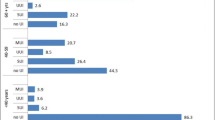Abstract
Introduction and hypothesis
The objective of this study is to evaluate dispositional optimism, pelvic floor disorder symptoms, and treatment decisions.
Methods
Scores of the Life Orientation Test-Revised were used to categorize women seeking clinical treatment for pelvic floor disorders as pessimists (scores in lowest third) or optimists (scores in highest third). Participants also listed their treatment goals and quantified pelvic floor symptom severity by completing the Pelvic Floor Distress Inventory (PFDI-20). We compared symptoms, goals, and treatment choices between optimists and pessimists.
Results
Three hundred sixteen patients were included, 31% pessimists and 38% optimists. Pessimists reported more goals and different types of treatment goals. Pessimists were also more likely to elect surgical treatment over more conservative treatment methods, although this trend did not reach statistical significance. Among patients with prolapse (≥stage 2), PFDI-20 prolapse subscale scores were inversely correlated with level of optimism, with pessimists reporting a higher level of bother than optimists.
Conclusions
In our study, pessimists reported more treatment goals, were more bothered by prolapse symptoms, and tended to be more likely to choose surgical treatments for their pelvic floor disorders than optimistic women.

Similar content being viewed by others
References
Elkadry EA, Kenton K, FitzGerald MP, Shott S, Brubaker L (2003) Patient-selected goals: a new perspective on surgical outcome. Am J Obstet Gynecol 175(1):10–17
Mahajan ST, Elkadry EA, Kenton K, Shott S, Brubaker L (2006) Patient-centered surgical outcomes: the impact of goal achievement and urge incontinence on patient satisfaction one year after surgery. Am J Obstet Gynecol 194:722–728
Barber MD, Brubaker L, Nygaard I, Wheeler TL 2nd, Schaffer J, Chen Z, Spino C (2009) Pelvic floor disorders network defining success after surgery for pelvic organ prolapse. Obstet Gynecol 114(3):600–609
Hullfish KL, Bovbjerg VE, Gurka MJ, Steers WD (2008) Surgical versus nonsurgical treatment of women with pelvic floor dysfunction: patient centered goals at 1 year. J Urol 179(6):2280–2285
Schou I, Ekeberg O, Sandvik L, Ruland CM (2005) Stability in optimism-pessimism in relation to bad news: a study of women with breast cancer. J Pers Assess 84(2):148–154
Scheier MF, Carver CS, Bridges MW (1994) Distinguishing optimism from neuroticism (and trait anxiety, self-mastery, and self-esteem): a reevaluation of the Life Orientation Test. J Pers Soc Psychol 67:1063–1078
Tindle HA, Chang YF, Kuller LH (2009) Optimism, cynical hostility, and incident coronary heart disease and mortality in the Women's Health Initiative. Circulation 25(120(8)):656–662
Allison PJ, Guichard C, Fung K, Gilain L (2003) Dispositional optimism predicts survival status 1 year after diagnosis in head and neck cancer patients. J Clin Oncol 1(21(3)):543–548
Barber MD, Kuchibhatla MN, Pieper CF, Bump RC (2001) Psychometric evaluation of 2 comprehensive condition-specific quality of life instruments for women with pelvic floor disorders. Am J Obstet Gynecol 185:1388–1395
Lowenstein L, FitzGerald MP, Kenton K, Dooley Y, Templehof M, Mueller ER, Brubaker L (2008) Patient-selected goals: the fourth dimension in assessment of pelvic floor disorders. Int Urogynecol J Pelvic Floor Dysfunct 19(1):81–84
Brubaker L, Shull B (2005) EGGS for patient-centered outcomes. Int Urogynecol J Pelvic Floor Dysfunct 16:171–173
Pham T, Kenton K, Mueller E, Brubaker L (2009) New pelvic symptoms are common after reconstructive pelvic surgery. Am J Obstet Gynecol 200(88):e1–e5
Wren PA, Janz NK, FitzGerald MP, Barber MD, Burgio KL, Cundiff GW, Nygaard IE, Zyczynski HM, Gao X (2008) Pelvic floor disorders network optimism in women undergoing abdominal sacrocolpopexy for pelvic organ prolapse. J Am Coll Surg 207(2):240–245
Conflicts of interest
E. Mueller is a consultant for BK Ultrasound and Allergan. L. Brubaker is a consultant for Pfizer. K. Kenton is a consultant for Intuitive Surgical.
Author information
Authors and Affiliations
Corresponding author
Rights and permissions
About this article
Cite this article
Lowenstein, L., Ramm, O., Mueller, E. et al. The impact of dispositional optimism on symptoms and treatment choices in patients with pelvic floor disorders. Int Urogynecol J 23, 295–298 (2012). https://doi.org/10.1007/s00192-011-1538-5
Received:
Accepted:
Published:
Issue Date:
DOI: https://doi.org/10.1007/s00192-011-1538-5




